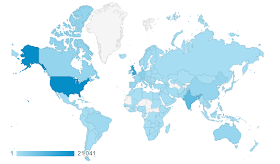Bioinformatics
has grown very quickly since the EBI opened 20 years ago, and I think it’s fair
to say that it will grow even faster over the next 20 years. Biology is being
transformed to a fundamentally information-centric science, and a key part of
this has been the aggregation of knowledge in large-scale databases. When you
put all the hard-won information about living systems together – their genome
sequences, variation, proteins, interactions with small molecules – they are,
potentially, incredibly useful. I say “potentially” because even the most
pristine, large, interconnected data collection in the world isn’t worth much
if people don’t know how to use it.
So at the EBI
we have this challenge of making sure researchers (a) know we have all this
amazing data for them, and (b) are able to use it. One aspect of this is
making easy to use, intuitive websites, which is something I’ve blogged about before.
But training, in all its forms, is really important.
A moving target
Not very
surprisingly, face-to-face interactions really make the biggest difference. Nothing
is better than having a person to guide you through using a resource (and
making sure you’re using the right one), which is why some seven years ago we
increased our training efforts substantially. We now run a huge number of
courses on the Genome Campus in Cambridge and deliver an even larger number
around the globe.
All this
training is coordinated in one team, but of course training is embedded in all the
different resource teams so the people actually leading the courses really know
their stuff. I know first-hand from days as co-lead of Ensembl how effective this can be.
These courses
have been taken out to over 200 sites in close to 30 countries, and they’ve
reached more than 7000 people. But as I said, bioinformatics is growing fast
and face-to-face training is just really hard to scale up. One way we are
dealing with that is through a train-the-trainer programme, which we run in
lots of different places, and while it’s effective, it’s just not enough.
Training online
So about three
years ago we launched Train
online, an e-learning platform set up to help molecular biologists
figure out how to make the best use of our resources, dipping in as time permits.
We now have 43 online courses, and over 60,000 people from close to 200
countries have visited Train online this year alone (effectively doubling the
number we had this time last year).
 |
| Location of Visitors to Train Online |
Good content first
These training
materials are put together by teams of people who put a lot of effort into
making them engaging and motivating. The way people learn individually (specifically,
using online tools) is rather different from the way they learn through
interacting with another person, so we try to accommodate this in a number of
ways, for example making more ‘bite-sized’ courses.
Face-to-face
training happens in real time and is fairly fluid, and there is a lot of
preparation that goes on right up to the moment a course starts. The workflow
for e-learning, on the other hand, needs constant reviewing and refreshing to
stay current, so someone with adequate expertise needs to stay on it.
(As a point of
interest, we assign DOIs to our courses so that the authors get recognition for
their work and so we can track citations of them.)
Production value matters
As
bioinformatics and computational techniques become increasingly important to
more and more applied fields – healthcare, agriculture, environmental research
and others – we will need to continue to innovate around how we train people. That
means anything from new, effective methods for training educators to making
e-learning platforms like Train online as interactive as possible.
High-quality
online courses need be inviting to explore, so that you remember what you learn
and are inspired to learn more. That requires significant infrastructure behind
it. You need much more than just the technical capacity to set things up
properly on the web – you need video equipment, editing and production
workflows, video hosting and a great interface… but more than anything, you
need solid in-house UX and multimedia expertise and you have to be ready to use
it.
Who needs it?
A rough,
back-of-the-envelope calculation estimates that there are up to 2 million life
science researchers worldwide, and depending on how you count all healthcare-related
research that number could go up to 4 million. If 100,000 people use Train
online this year, our online learning resource alone will reach between 2% and
10% of the scientists who probably need bioinformatics training. That’s a pretty
good start, but there’s a long way to go.
So if you
haven’t had a look at Train online yet, please do – you might be surprised.
It’s one innovation we’re particularly proud of, and we’re looking forward to
seeing more in the future.
Hello Ewan,
ReplyDeletefrom Washington State, US
desk of Mark McGary.
Just superb work. thank you for your support in training regards.
Recommend a link to Coursera, Peking University,
Introduction to bioinformatics.
Excellent forum topics.
Interesting group of students.
M.
SAP HANA Online Training Hyderabad. Best online training
ReplyDeleteinstitute for SAP Hana. Get your demo now for free of cost.
Having such a great ideas, that other can also get best learning from it.
ReplyDeleteBest Prom Dresses